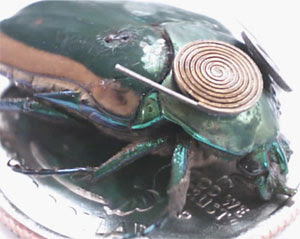BBC News - Cyborg search-and-rescue insects' power source unveiled
Efforts to create an army of cyborg insects are being pursued by a team of US-based engineers.The group is investigating ways to harvest energy from the creatures to power sensors and other equipment fastened to their bodies.
The team has created an energy scavenging device that is attached close to the insects' wings.
It suggested the creatures might one day be used to aid search-and-rescue operations and surveillance.
The University of Michigan team of engineers published their study in the Journal of Micromechanics and Microengineering.
Michigan Engineering | Insect cyborgs may become first responders, search and monitor hazardous environs
Professor Khalil Najafi, the chair of electrical and computer engineering, and doctoral student Erkan Aktakka are finding ways to harvest energy from insects, and take the utility of the miniature cyborgs to the next level.
"Through energy scavenging, we could potentially power cameras, microphones and other sensors and communications equipment that an insect could carry aboard a tiny backpack," Najafi said. "We could then send these 'bugged' bugs into dangerous or enclosed environments where we would not want humans to go."
The principal idea is to harvest the insect's biological energy from either its body heat or movements. The device converts the kinetic energy from wing movements of the insect into electricity, thus prolonging the battery life. The battery can be used to power small sensors implanted on the insect (such as a small camera, a microphone or a gas sensor) in order to gather vital information from hazardous environments.
Three energy-scavenging prototypes: (Top) A piezoelectric cantilever beam attached lengthwise along the beetle’s body generates 11.5 µW. (Middle) Piezoelectric cantilever beams attached across the beetle’s body each generate 7.5 µW. (Bottom) Piezoelectric spiral beams attached on the beetle’s thorax each generate 22.5 µW. Image credit: Aktakka, et al.
The U-M team examined several techniques to scavenge energy from wing motion with their results were published in a paper titled "Energy scavenging from insect flight," which was recently published in the Journal of Micromechanics and Microengineering. The university is now pursuing a patent for the technology and is seeking commercialization partners to bring it to market.
Getting the insects to go where their handlers want them to is another part of the puzzle that needs to be solved before insect cyborgs can be deployed. But DARPA has been working on this, having put out a call some years back for research proposals for Hybrid-Insect-Micro-Electro-Mechanical Systems (HI-MEMS) interfaces to control the movement of living insects. Combining the two technologies could be just the thing to take insect cyborgs to the next level and see them used to monitor hazardous situations in the not to distant future.
Related
- Professor Khalil Najafi Univerisity of Michigan EECS
- Insect cyborgs may become first responders, search and monitor hazardous environs
- Harvesting Power From Flying Insects: Science Fiction in the News
- Cyborg MAV Beetles Powered By Electricity Generated From Their Own Wings | HighTech EDGE
- Researchers Developing Cyborg Insects that Draw Energy From Their Own Wings Researchers Developing Cyborg Insects that Draw Energy From Their Own Wings – Inhabitat - Green Design Will Save the World
- Cyborg insects and trust « FrogHeart
- Energy scavenging from insect flight

